|
"CASSINI, J. - DISCOVERY OF THE INCLINATION OF A SATELITTE.
Nouvelles Decouvertes sur les Mouvements des Satellites de Saturne.
(Paris, L'Imprimerie Royale, 1717). 4to. Without wrappers. Extracted from ""Mémoires de l'Academie des Sciences. Année 1714"". Pp.361-378 and 1 folded engraved plate.
Bookseller reference : 45962
|
|
|
"ØRSTED (OERSTED), H.C. - THE DISCOVERY OF ELECTROMAGNETISM - FIRST ANNOUNCEMENT IN FRENCH.
Experimenta circa Effectum, etc. Expériences sur l'effet du conflict électrique sur l'aiguille animantée.
(Paris, Crochard, 1820). No wrappers. In ""Annales"". In ""Annales de Chimie et de Physique, Par MM. Gay-Lussac et Arago"" Tome XIV, Cahier 4, Titlepage to vol. 14 + pp. 337-442. (Entire issue offered). Ørsted's paper: pp. 417-25. A few scattered brownspots.
Bookseller reference : 46026
|
|
|
"UNVERDORBEN, OTTO. - THE DISCOVERY OF ANILINE.
Ueber das Verhalten der organischen Körper in höheren Temperaturen.
Leipzig, Johann Ambrosius Barth, 1826. Contemp. hcalf. Gilt spine. A few scratches to spine. In ""Annalen der Physik und Chemie. Hrsg.von Poggendorff"", Bd. 8. (10),526 pp. and 3 folded engraved plates. Small stamps onverso of titlepage. (Entire volume offered). Unverdorben's paper: pp. 253-265, 397-410, 477-487. Clean and fine.
Bookseller reference : 46031
|
|
|
"DAVY, HUMPHRY - THE DISCOVERY OF HYDROGEN TELLURIDE - THE RIVALRY WITH GAY-LUSSAC & THENARD.
Nouvelles Recherches électro-chimiques, principalement relatives aux substances métalliques tirées des alcalis et de terres, et à quelques combinations de l'Hydrogène. (+) Suite des Recherches... (+) Sur les Observations sur les Recherches faites p...
Paris, J. Klostermann, 1810. Contemp. hcalf. Spine gilt. Slightly rubbed. A few scratches to binding. Small stamps on verso of titlepage.In: ""Annales de Chimie, ou Recueil de Mémoires concernant la Chemie"" Tome 75. 336 pp. a. 2 folded engraved plates. Some scattered brownspots. The papers: pp. 27-77, 129-175, 256-263, 264-273, 274-289 a. 290-316.
Bookseller reference : 46377
|
|
|
"DUFAY (DU FAY), CHARLES FRANCOIS DE CISTERNAY. - THE DISCOVERY OF POSITIVE AND NEGATIVE CHARGE OF ELECTRICITY.
Premier- (Quatrième) Mémoire sur L'Électricitè. (1. Histoire de L'Électricité. 2. Quels sont les Corps qui sont susceptibles d'Électricité. 3. Des Corps qui sont le plus vivement attirés par les matiéres électriques, & de ceux qui sont les plus p...
(Paris, L'Imprimerie Royale, 1735). 4to. Without wrappers. Extracted from ""Mémoires de l'Academie des Sciences. Année 1733"". Pp. 23-39, pp. 73-84, pp. 233-254 a. 1 engraved plate, pp. 457-476. With titlepage to the volume (1733/1735). Margins of titlepage with a few brownspots.
Bookseller reference : 46590
|
|
|
"HUDDART, JOSEPH. - DISCOVERY OF COLOR-BLINDNESS.
An Account of Persons who could not distinguish Colours. In a Letter to Joseph Priestly.
London, W. Bowyer and J. Nichols, 1777. 4to. Extracted from ""Philosophical Transactions"", Year 1777. Vol. 67 - Part I. Pp. 260-265. Clean and fine, broadmargined.
Bookseller reference : 46614
|
|
|
"CURIE, (MARIE) SKLODOWSKA. - THE DISCOVERY OF THE RADIOACTIVITY OF THORIUM - COINING THE TERM 'RADIOACTIVITY'
Rayons émis par les composés de l'uranium et de thorium. Presentée par M. Lippmann. Séance du Mardi 12 Avril 1898).
Paris, Gauthier-Villars, 1898. 4to. No wrappers. In: ""Comptes Rendus Hebdomadaires des Séances de L'Academie des Sciences"", Tome 126, No 15). Entire issue offered. With htitle and titlepage to vol. 126. Pp. 1059-1110. Curie's paper: pp. 1101-1103.
Bookseller reference : 46852
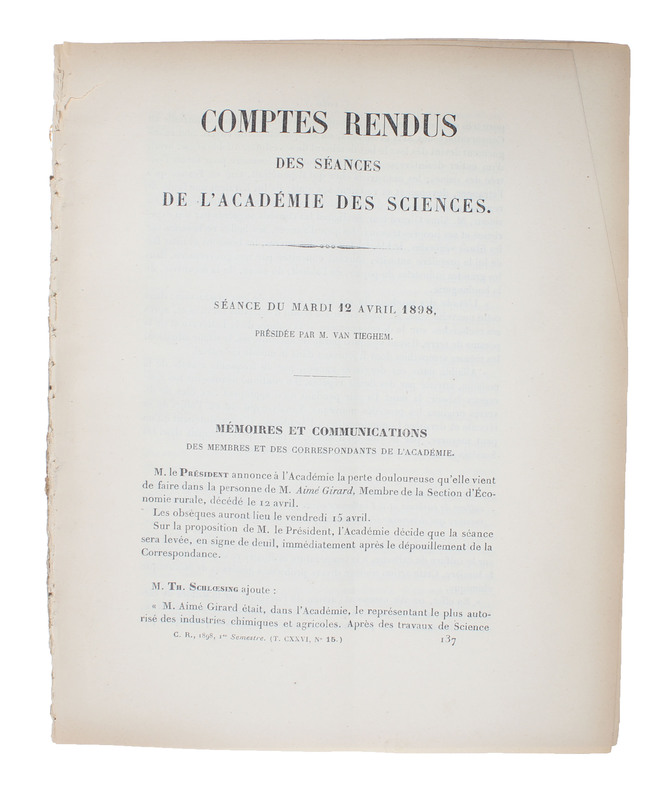
|
|
|
"BECQUEREL, HENRI. - THE DISCOVERY OF RADIO-ACTIVITY - THE BEGINNING OF THE NUCLEAR AGE
Sur les radiations émises par phosphorescence. (+) Sur les radiations invisibles émises par les corps phosphorescents. (+) Sur quelques propriétés nouvelles des radiations invisibles émises par divers corps phosphorescents. (+) Sur les radiation...
Paris, Gauthier-Villars, 1896. 4to. Near contemp. full cloth. Spine gilt and with gilt lettering. Bookmark, ""The Chemists Club"" in gold on lower part of spine. Light wear along edges. In: ""Comptes Rendus Hebdomadaires des Séances de L'Academie des Sciences"", Tome 122 (Entire volume offered).1633 pp. The papers: 420-421, pp. 501-502, pp. 559-564, pp. 689-694, pp. 762-767 and pp. 1086-1088.
Bookseller reference : 46854
|
|
|
"BROGLIE (DEBROGLIE), LOUIS de. - DISCOVERY OF THE WAVE THEORY OF MATTER AND CREATION OF WAVE-MECHANICS.
Ondes et quanta. Note de M. Louis de Broglie, présentée par M. Jean Perrin. (Séance du 10 Septembre 1923). (+) Quanta de lumière, diffraction et interférences. Note de M. Louis de Broglie, transmise par M. Jean Perrin. (Séance du 24 Septembre 1923). (...
Paris, Gauthier-Villars et Cie, 1923. 4to. Bound in 2 contemp. full cloth. Spines gilt and with gilt lettering. In: ""Comptes Rendus Hebdomadaires des Séances de L'Academie des Sciences"", Tome 177. With htitle a. titlepage. 1513 pp. (Entire volume offered). De Broglie's papers: pp. 507-510, pp. 548-551 a. pp. 630-32. Clean and fine. A stamp to verso of titlepage.
Bookseller reference : 46949

|
|
|
"BROGLIE, LOUIS de. - DISCOVERY OF THE WAVE THEORY OF MATTER AND CREATION OF WAVE-MECHANICS.
A Tentative Theory of Light Quanta.
London, Taylor and Francis, 1924. Later full buckram, gilt lettering to spine. In: Philosophical Magazine conducted by Oliver Joseph Lodge etc."", Vol. 47. - Sixth Series. VIII,1168 pp. and 8 plates. (Entire volume offered). De Broglie's paper: pp. 446-458. Internally clean and fine.
Bookseller reference : 46950
|
|
|
"CHADWICK, J. (JAMES) & E.S. BIELER. - THE DISCOVERY OF THE STRONG NUCLEAR FORCES.
The Collisions of alpha particles with Hydrogen Nuclei.
(London, Taylor and Francis), 1921. Blank wrapper. In: ""The London, Edinburgh, and Dublin Philosophical Magazine and Journal of Science"" Sixth Series, Vol.42, No. 252, December 1921. Pp. 873-1024, textillustr. a. 1 plate. (Entire issue offered). Chadwick & Bieler's paper: pp. 923-940, textillustr.
Bookseller reference : 46992
|
|
|
"HENRY, JOSEPH. - DISCOVERY OF SELF-INDUCTION.
Facts in reference to the Spark, &c from along conductor uniting the poles of a Galvanic Battery.
Philadelphia, Fraklin Institute, 1835. 8vo. Later full green cloth. Tome-and titlelabels in leather with gilt lettering on spine. In: ""Journal of the Franklin Institute of the State of Pennsylvania... Edited by Thomas P. Jones"", Vol. XV. New series. Engraved frontisp. (2),446 pp., 2 folded engraved plates and 2 folded engraved maps. (Entire volume offered). Henry's announcement: pp. 169-70. A stamp to verso of frontispiece (Library of Congress duplicate stamp).
Bookseller reference : 47003
|
|
|
"CURIE, JACQUES et PIERRE. - THE DISCOVERY OF PIEZOELECTRICITY.
Développement, par pression, de l'èlectricité polaire dans les cristaux hémièdres à faces inclinées. Note de MM. Jacques et Pierre Curie, présentée par M. Friedel.
Paris, Gauthier-Villars, 1880. 4to. No wrappers. In: ""Comptes Rendus Hebdomadaires des Séances de L'Academie des Sciences"", Tome 91, No 5 (entire issue offered). Pp. 251-310. The Curie's paper: pp. 294-295.
Bookseller reference : 47008
|
|
|
"RAOULT, F.-M. (FRANCOIS MARIE). - DISCOVERY OF RAOULT'S LAWS.
Loi générale de congélation des dissolvants, Mémoire de... (Extrait par l'auteur). (+) Loi générale des tensions de vapeur des dissolvants. (2 Papers).
(Paris, Gauthier-Villars), 1882. 4to. No wrappers. In: ""Comptes Rendus Hebdomadaires des Séances de L'Academie des Sciences"", Tome 95, No 22 a. Tome 104 No 21 (entire issues offered). Pp. 1017-1076 and pp. 1387-1462. Raoult's papers: pp. 1030-33 (tome 95) and pp. 1430-1433 (tome 104).
Bookseller reference : 47024
|
|
|
"WURTZ, ADOLPHE. - ANNOUNCING THE DISCOVERY OF THE AMINES IN CHEMISTRY.
Sur une série d'alcalis organiques homologues avec l'ammoniaque.
(Paris, Bachelier), 1849. 4to. No wrappers. In: ""Comptes Rendus Hebdomadaires des Séances de L'Academie des Sciences"", Tome 28, No 7. Pp. 189-240 (entire issue offered). Wurtz's paper: pp. 223-226.
Bookseller reference : 47031
|
|
|
"COMPTON, ARTHUR HOLLY. - THE DISCOVERY OF THE COMPTON-EFFECT, NOBEL PRIZE PAPER.
A Quantum Theory of the scattering of X-Rays by Light Elements.
Lancaster, The Physical Review, 1923. Royal8vo. Contemp. full buckram. In:""The Physical Review"", Series II, vol. 21. (4),736 pp., Plates and textillustr. (Entire volume offered). A perforated stamp in upper margin on a few leaves. Compton's paper: pp. (483-) 501.
Bookseller reference : 47061
|
|
|
"CURIE, IRÈNE et M.F. JOLIOT. - ANNOUNCING THE DISCOVERY OF ARTIFICIAL RADIOACTIVITY - NOBEL PRIZE PAPER OF 1935.
Un nouveau type de radioactivité. (Séance du 15 Janvier 1934).
Paris, Gauthier-Villars, 1934. 4to. No wrappers. In: ""Comptes Rendus Hebdomadaires des Séances de L'Academie des Sciences"", Tome 198 No 3. Titlepage to vol. 198. Pp. (213-) 292. (Entire issue offered). The joint paper: pp. 254-256 a. 1 photographic illustration in the text. Titlepage with a stamp on verso, 2 small tears and a tiny bit of upper right corner gone. Titlepage a bit browned.
Bookseller reference : 47071
|
|
|
"LEIBNIZ (LEIBNITZ), G.F. - CHRISTIAAN HUYGENS - JOHANN BERNOULLI - JACOB BERNOULLI ET AL. - THE DISCOVERY OF THE ""CATENARY CURVE"" , THE ""LOGARITHMIC CURVE"" AND THE ""POLAR COORDINATES"".
1. De Linea in quam Flexile se pondere proprio curvat, ejeuque usu insignia adinveniendi quotcunque medias proportionales & Logarithmos. - 2. De Solutionibus Problematis Catenarii vel Funicularis in Actis A. 1691, aliisque a Dn. I.B. propositis. (1-2:...
Leipzig, Grosse & Gleditsch, 1691. 4to. Contemp. full vellum. Faint handwritten title on spine. a small stamp on titlepage. In: ""Acta Eruditorum Anno MDCLXXXXI"". (8),590,(6) pp. and 13 (of 15) folded engraved plates. The 2 first plates lacks, but they do not belong to the papers listed.Leibniz' papers: pp.277-281 a. 1 plate, pp. 435-439. Johann Bernoulli: pp. 274-276 a. 1 plate. Huygens: pp. 281-282. - Jacob Bernoulli: pp. 282-290 a. 1 plate.
Bookseller reference : 41859
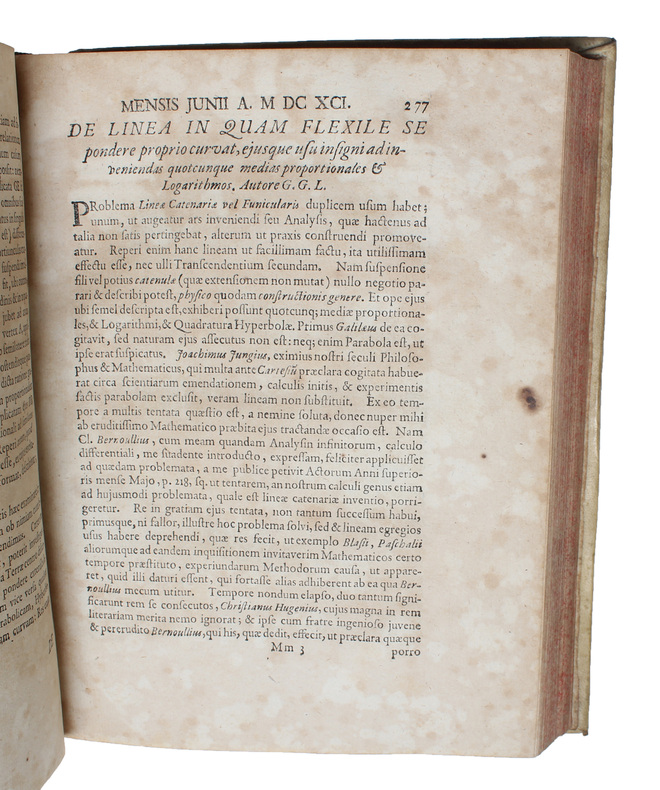
|
|
|
"RUTHERFORD, ERNEST - NIELS BOHR - C.G. DARWIN. - THE DISCOVERY OF THE 'PROTON'.
The Structure of the Atom. (Rutherford) + (Darwin:) Collision of 'alpha' Particles with Light Atoms. + (Bohr:) On the Effect of Electric and Magnetic Fields on Spectral Lines
London, 1914. No wrappers, but stiched. All three papers contained in: ""Philosophical Magazine"", Sixth Series, Vol. 27. No. 159. March 1914. The whole issue issue offered (=no. 159): pp. 397-540 and 2 plates.Rutherford's paper.pp. 488-498. - Darwin's paper: pp. 499-506. - Bohr's paper: pp. 506-523. All clean and fine.
Bookseller reference : 41545
|
|
|
"FARADAY, (MICHAEL). - ON THE DISCOVERY OF ELECTOMAGNETIC INDUCTION.
(Lettré) A M. Gay-Lussac. Institution royale, Ier décembre 1832. (The letter ""On Magneto-electric Induction"").
(Paris, Crochard, 1832). No wrappers. In: ""Annales de Chimie et de Physique"", 2e Series, vol. 51, Cahier 4. Pp. 337-444 (Entire issue offered). Faraday's letter: pp. 404-434 a. 1 engraved plate. Some brownspots.
Bookseller reference : 48329
|
|
|
"SOUBEIRAN, EUGÈNE - THE DISCOVERY OF CHLOROFORM.
Recherches sur quelques Combinaisons du Chlore.
Paris, Crochard, 1831. No wrappers as extracted from ""Annales de Chimie et de Physique"", 2. Series, Tome 48. Titlepage to vol. 48. Pp. 113-157. A few brownspots, but fine. Small stamps on verso of titlepage.
Bookseller reference : 43365
|
|
|
"PASTEUR, (LOUIS). - THE DISCOVERY OF ANAEROBIC LIFE.
Animalcules infusoires vivant sans gaz oxygène libre et déterminant des fermentations.
(Paris, Mallet-Bachelier), 1861. 4to. No wrappers. In: ""Comptes Rendus Hebdomadaires des Séances de L'Academie des Sciences"", Tome 52, No 8. Pp. (321-) 368. (Entire issues offered). Pasteur's paper: pp. 344-347. Minor marginal brownspots.
Bookseller reference : 53357
|
|
|
INGEN-HOUSZ (INGENHOUSZ), JOHN. - DISCOVERY OF PHOTOSYNTHESIS - THE CLASSIC OF ECOLOGY.
Expériences sur les Végétaux, spécialement sur la Propriété qu'ils possèdent à un haut degré, soit d'améliorer l'Air quand ils sont au foleil, soit de corrompre la nuit. ou lorsqu'ils sont à l'ombre" auxquelles on a joint unde Méthode nouvelle...
Paris, Théophile Barrois, 1780. 8vo. Fine cont. full mottled calf, richly gilt spine and gilt titlelabel in red leather. Edges gilt. LXVIII,333,(3) pp. and 1 folded engraved plate (showing his experimental apparatus). Light browning to margins of title-page, otherwise clean and with broad margins. A fine copy.
Bookseller reference : 53319
|
|
|
"PAYEN, A. et J.F. PERSOZ - DISCOVERY OF THE FIRST ENZYME, DIASTASE.
Mémoire sur la diastase, les principaux produits de ses réactions et leurs applications aux arts industriels"" (Memoir on diastase, the principal products of its reactions, and their applications to the industrial arts),
Paris, Crochard, 1833. Contemp. hcalf. Raised bands, gilt spine with gilt lettering. A few scratches to spine. Stamps to verso of titlepage. In: ""Annales de Chimie et de Physique, Par MM. Gay-Lussac et Arago."", Series 2, tome 53. Entire volume offered. 448 pp. Payen & Persoz's paper: pp. 73-92. Clean and fine.
Bookseller reference : 51493
|
|
|
"VILLARD, P. (PAUL ULRICH). - THE DISCOVERY OF GAMMA RAYS AND GAMMA RADIATION.
Sur la réflexion et la réfraction des rayons cathodiques et des rayons déviables du radium. (+) Sur le rayonnement du radium.
(Paris, Gauthier-Villars, 1900). 4to. No wrappers. In: ""Comptes Rendus Hebdomadaires des Séances de L'Academie des Sciences"", Tome 130, No 15 a. No 18. Pp. (962-) 1044 a. pp. (1145-) 1220. Entire issues offered. Villard's papers: pp. 1010-1012 a. 1178-1182, textillustrations. Clean and fine.
Bookseller reference : 51313
|
|
|
"DAVY, HUMPHRY - THE DISCOVERY OF POTASSIUM AND SODIUM (FRENCH VERSION).
Recherches ëlectrochimiques sur la décomposition des terres, avec des observations sur les métaux obtenus des terres alcalines, et sur un amalgame produit avec l'ammoniaque. Tireeis des Transactions philosophiques, et traduites par M. C.A. Prieur. (+)...
Paris, Mad. Ve Barnard, 1809. Contemp. hcalf. Spine gilt. Wear to top of spine. A few scratches to binding. Small stamps on verso of titlepage.In: ""Annales de Chimie, ou Recueil de Mémoires concernant la Chemie"" Tome 70. 336 pp. (Entire volume offered). Davy's paper: pp. 189-254.
Bookseller reference : 50198
|
|
|
"BROGLIE (DE BROGLIE), LOUIS DE . - DISCOVERY OF THE WAVE THEORY OF MATTER AND CREATION OF WAVE-MECHANICS
Ondes et quanta. Note de M. Louis de Broglie, présentée par M. Jean Perrin. (Séance du 10 Septembre 1923). (+) Quanta de lumière, diffraction et interférences. Note de M. Louis de Broglie, transmise par M. Jean Perrin. (Séance du 24 Septembre 1923). (...
Paris, Gauthier-Villars et Cie, 1923. 4to. Bound in one contemp. full buckram. Spines gilt and with gilt lettering. In: ""Comptes Rendus Hebdomadaires des Séances de L'Academie des Sciences"", Tome 177. Bound with orig. printed front-wrapper to No. 1, half-title and title-page to vol. 177. 1513 pp. (Entire volume offered). De Broglie's papers: pp. 507-510, pp. 548-551 a. pp. 630-32. Clean and fine. A punched stamp on foot of title-page.
Bookseller reference : 49718
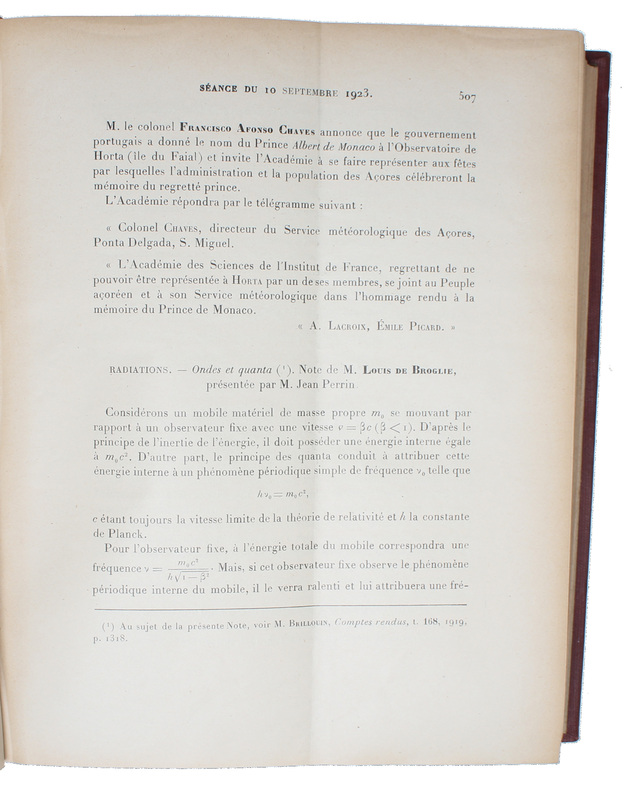
|
|
|
"SEFSTRÖM, N.-G. (NILS GABRIEL). - THE DISCOVERY OF VANADIUM.
Sur le Vanadium, métal nouveau, trouvé dans du fer en barres de Eckersholm. forge qui tire sa mine de Taberg, dans le Smaland.
(Paris, Crochard, 1831). No wrappers. In: ""Annales de Chimie et de Physique, Par MM. Gay-Lussac et Arago."", tome 46, Cahier 1. Pp. 5-112. (Entire issue offered). Sefström's paper: pp. 105-111.
Bookseller reference : 49631
|
|
|
"SOUBEIRAN, EUGÈNE - THE DISCOVERY OF CHLOROFORM.
Recherches sur quelques Combinaisons du Chlore. (Communiqué par l'auteur).
Paris, Crochard, 1831. Contemp. hcloth. Some scattered brownspots. ""Annales de Chimie et de Physique"", 2. Series, Tome 48. 448 pp., 1 engraved plate. (Entire volume offered). Soubeiran's paper: pp. 113-157. Scattered brownspots.
Bookseller reference : 49604
|
|
|
"BECQUEREL, HENRI., MARIE CURIE, PIERRE CURIE, GUSTAVE BÉMONT, EUGÈNE DEMARÇAY. - THE DISCOVERY OF RADIOACTIVITY, RADIUM & POLONIUM DISCOVERED.
(Nine papers documenting the discovery of radioactivity, the discovery of Radium and Polonium:) 1. Becquerel: Sur les radiations émises par phosphorescence. 2. Becquerel: Sur les radiations invisibles émises par les corps phosphorescents. 3. Becq...
Paris, Gauthier-Villars, 1896 a. 1898. 4to. Bound in 2 contemp. hcloth, spines gilt and with gilt lettering. In: ""Comptes Rendus Hebdomadaires des Séances de L'Academie des Sciences"", Tome 122 a. 127. - 1633 pp. + 1302 pp. Both with halftitle and title-page. Title-pages with a punched stamp to lower margin. The papers (tome 122:) pp. 420-421, 501-503, 559-564, 689-694, 762-767, 1086-1088. (Tome 127:) pp. 175-178, 1215-1217, 1218. Internally clean and fine.
Bookseller reference : 49475

|
|
|
"PASTEUR, LOUIS. - ANNOUNCING THE DISCOVERY OF ""MOLECULAR ASSYMETRY""
Mémoire sur la relation qui peut exister entre la forme cristalline et la composition chimique, et sur la cause de la polarisation rotatoire"" (Extrait). (Séance du Lundi 22 Mai 1848).
(Paris, Bachelier), 1848. 4to. No wrappers. In: ""Comptes Rendus Hebdomadaires des Séances de L'Academie des Sciences"", Tome 26, No 21. Pp. (529-) 548. (Entire issue offered). Pasteur's paper: pp. 535-538. Clean and fine.
Bookseller reference : 49456
|
|
|
"PASTEUR, LOUIS. - DISCOVERY OF ""MOLECULAR ASSYMETRY""
Recherches sur les relations qui peuvent exister entre la forme cristalline, la composition chimique et le sens de la polarisation rotatoire. (+) Note sur la Cristallisation du soufre. (Memoir on the relation that can exist between crystalline form an...
Paris, Victor Masson, 1848 a. 1851. 8vo. 2 contemp. hcalf, raised bands, gilt spine. Light wear along edges. Small stamps on verso of titlepages and on verso of 1 plate. In ""Annales de Chimie et de Physique"", 3me Series - Tome XXIV and XXXI. (6),512 pp. and 2 plates + 512 pp. a. 4 plates.(2 entire volumes offered). Pasteur's papers: pp. 442-459 a. pp. 459-460, 1 double-page folded engraved plate + pp. 67-102 a. 1 plate. Some scattered brownspots to first part of the first volume, not affecting P's papers.
Bookseller reference : 49336
|
|
|
"BRAUN, FERDINAND. - THE DISCOVERY OF SEMICONDUCTOR RECTIFIER EFFECT.
Ueber die Stromleitung durch Schwefelmetalle.
Leipzig, Johann Ambrosius Barth, 1874. 8vo. Contemp. hcalf. 5 raised bands, gilt spine and gilt lettering to spine. A few scratches to spine. Small stamp on verso of first -and general- titlepage. In: ""Annalen der Physik und Chemie. Hrsg. von J.C. Poggendorff"", Sechste Reihe Bd. 3, (= Poggendorff Bd. 153). X,636 pp., 4 plates. (Entire volume offered). Braun's paper: pp. 556-563.
Bookseller reference : 49327
|
|
|
"RAMSAY, WILLIAM & PER THEODOR CLEVE. - THE INDEPENDENTLY DISCOVERY OF HELIUM ON EARTH
On a Gas showing the Spectrum of Helium, the reputed cause of D3, one of the Lines in the Coronal Spectrum. preliminary Note. (Received March 26, 1895). (+) Helium, a Gaseous Constituent of certain Minerals. Part I. And (P.E. CLEVE:) Sur la présence d...
London, arrison and Sons, 1895. - (Paris, Gauthier-Villars), 1895. 8vo. and 4to. Later full cloth, gilt lettering to spine (Ramsay) and without wrappers (Cleve). In ""Proceedings of the Royal Society"" (Ramsay), Vol. 58. (Entire vol. offered). And in ""Comptes Rendus Hebdomadaires des Séances de L'Academie des Sciences"" (Cleve), Tome 120, No 15. Pp. (797-) 850. (Entire issue offered). Ramsay's papers: pp. 65-67 and pp. 81-89. - Cleve's paper: p. 834. Stamps tp edges and a few corners a bit bumped on vol. 58, otherwise clean and fine.
Bookseller reference : 49284
|
|
|
"BERZELIUS - THE DISCOVERY OF THORIUM.
Untersuchung eines neuen Minerals und einer darin enthaltenen zuvor unbekannten Erde.
Leipzig, Johann Ambrosius Barth, 1829. Without wrappers as issued in ""Annalen der Physik und Chemie. Hrsg.von Poggendorff"", Bd. 16, Siebentes Stück. (2) + pp., 1 folded engraved plate. Entire issue offered with titlepage to volume 16. Berzelius's paper: pp. 387-415. Clean and fine.
Bookseller reference : 49248
|
|
|
"RAYLEIGH, LORD (J.W. STRUTT) and WILLIAM RAMSAY. - THE DISCOVERY OF ARGON.
Argon, a New Constituent of the Atmosphere. Received and Read January 31, 1895.
London, Harrison and Sons, 1895. 4to. Orig. full cloth. Gilt lettering to spine. Blindtooled covers. First corner a bit bumped. In ""Philosophical Transactions"", Vol. 186 - I, Series A. XIV,(2),602,(4) pp. (Entire volume offered). The paper: p. 187-241 a. 8 textillustrations (apparatus). The title-page with faint brownspots. Otherwise internally clean and fine.
Bookseller reference : 49207
|
|
|
"POINCARE, H. (HENRI). - THE DISCOVERY OF AUTOMORPHIC FORMS.
Sur les fonctions fuchsiennes. (+) Sur les fonctions.... Note. (+) Sur les fonctions.... Note.
(Paris: Gauthier-Villars), 1882. 4to. No wrappers. In: ""Comptes Rendus Hebdomadaires des Seances de l'Academie des Sciences"", Vol 94, No 4 + 15 + 17. Pp. (149-) 184, pp. (997--) 1068 a. pp. (1139-) 1214. (3 entire issues offered). Poincare's papers: pp. 163-168, 1038-1042 a. 1166-67.
Bookseller reference : 49173
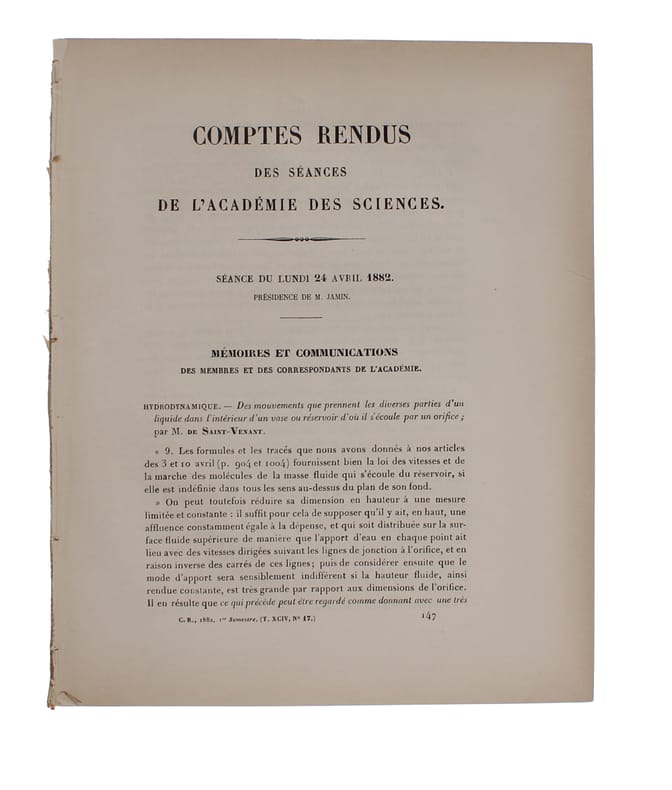
|
|
|
"VULPIAN, (EDME FÉLIX ALFRED). - DISCOVERY OF ADRENALINE.
Note sur quelques réactions propres à la substance des capsules surrénales.
(Paris, Mallet-Bachelier, 1856). 4to. No wrappers. In: ""Comptes Rendus Hebdomadaires des Séances de L'Academie des Sciences"", Tome 43, No 13. Pp. (637-) 672. (Entire issue offered). Vulpian's paper: pp. 663-665.
Bookseller reference : 49036
|
|
|
"FARADAY, MICHAEL. - THE DISCOVERY OF ELECTRO-MAGNETIC INDUCTION (PMM 308) - FRENCH VERSION.
Recherches expérimentales sur l'Electricité. I-V. (I. Sur l'induction des courans l'èlectriques. II. Sur le développement de l'électricité par le magnetisme. III. Sur une nouvelle condition électrique de la matière. IV. Sur les phénomènes magnét...
Paris, Crochard, 1832. Contemp. hcloth, gilt lettering to spine. In: ""Annales de Chimie et de Physique, Par MM. Gay-Lussac et Arago."", tome 50, Series 2. (Entire volume offered). 448 pp. 2 folded engraved plates. Faraday's papers: pp. 5-67 a. pp. 113-162. Some scattered brownspots.
Bookseller reference : 48987
|
|
|
"BERNARD, CLAUDE. - THE DISCOVERY OF THE GLYCOGENIC FUNCTION OF THE LIVER.
Sur une nouvelle fonction du foie chez l'homme et les animaux. (Extrait par l'auteur).
(Paris, Bachelier),1850. 4to. No wrappers. In: ""Comptes Rendus Hebdomadaires des Séances de L'Academie des Sciences"", Tome XXXI, No. 17. With titlepage to vol. 31. Pp. (561-) 592. (Entire issue offered). Bernard's paper: pp. 571-574. Titlepage with a faint stamp to top and a stamp in lower margin.
Bookseller reference : 48830
|
|
|
"SOBRERO, ASCAGNE. - THE DISCOVERY OF NITROGLYCERIN.
Sur plusieur composés détonants produits avec l'acide nitrique et le sucre, la dextrine, la lactine, la mannite et la glycérine.
(Paris, Bachelier),1847. 4to. No wrappers. In: ""Comptes Rendus Hebdomadaires des Séances de L'Academie des Sciences"", Tome XXIV, No. 7. Pp. (209-) 252. (Entire issue offered). Sobrero's paper: pp. 247-248. Clean and fine.
Bookseller reference : 48815
|
|
|
"POINCARÉ, HENRI. - THE DISCOVERY OF AUTOMORPHIC FUNCTIONS
Theorie des Groupes fuchsiens (+) Mémoire sur les Fonctions fuchsiennes (+) Sur les Fonctions de deux Variables (+) Mémoire sur les groupes kleinéens (+) Sur les groupes des équations linéaires (+) Mémoire sur les fonctions zétafuchsiennes. - [THE DISCOVERY OF AUTOMORPHIC FUNCTIONS]
Berlin, Stockholm, Paris, F. & G. Beijer, 1882-84. Large4to (272 x 230 mm). Three volumes uniformly bound in contemporary half calf with gilt lettering to spine. In ""Acta Mathematica"", volume 1-5. Light wear to extremities, boards and spines with scratches. Stamp to verso of front board in all volumes. First three leaves in first volume detached, otherwise internally fine and clean. Vol. I, pp. 1-62" Pp. 193-294 Vol. II, pp. 97-113 Vol. III. pp. 49-92 Vol. IV pp. 201-312" Vol. V pp. 209-278.
Bookseller reference : 60243
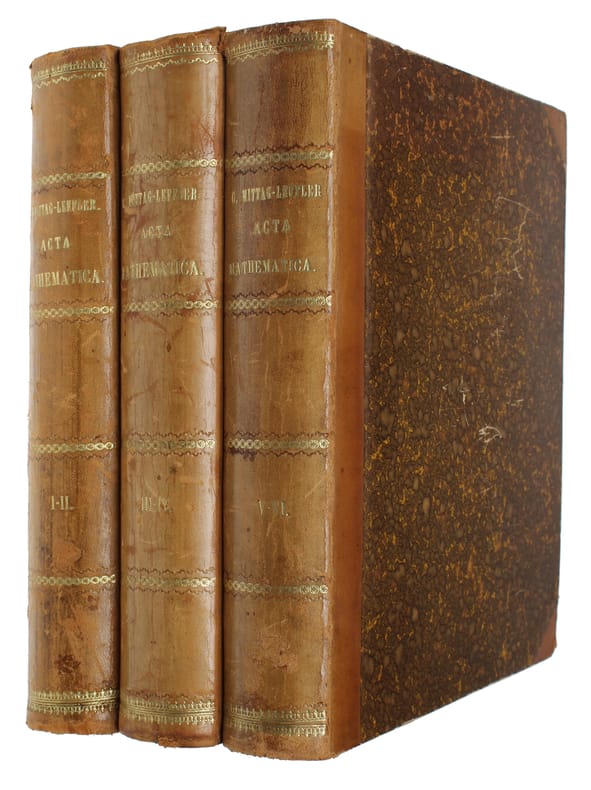
|
|
|
"FLATEYJARBOK - THE DISCOVERY OF AMERICA.
The ""Flatey Book"" ""Flatö Bogen"". Published by the Royal Danish General Staff, Topographical Department.
Copenhagen, 1893. Folio. (51 x 45 cm.). Orig. printed clothbacked boards. Stamp on title-page. 28 pp. ""In the present reproduction only those few pages are printed, which concerns the discovery of America by the Northmen in the first years of the 11th century."". Lower right corners damaged by insect-bites, no loss of text. Old Norse text, English and Danish translation.
Bookseller reference : 59360
|
|
|
"DONNÉ, AL. (ALFRED). - THE DISCOVERY OF BLOOD-PLATELETS.
De l'origine des globules du Sang, de leur mode de formation et de leur fin.
(Paris, Bachelier), 1842. 4to. No wrappers. In: ""Comptes Rendus Hebdomadaires des Séances de L'Academie des Sciences"", Tome 14, No. 10. Pp. (349-) 378. (Entire issue offered). Donné's paper: pp. 366-368.
Bookseller reference : 59217
|
|
|
"JANSSEN, PIERRE JULES. - DISCOVERY OF THE FIRST ALIAN ELEMENT, HELIUM.
Observations spectrales prises pendent l'éclipse du 18 août 1868, et methode d'observation des protubérances des éclipses... Calcutta, 3 octobre 1868.
(Paris, Gauthier-Villars), 1869. 4to. In: ""Comptes Rendus Hebdomadaires des Séances de L'Academie des Sciences"", Tome 68, No 7. Pp. (349-) 408. (Entire issue offered). Janssen's paper pp. 367-376.
Bookseller reference : 59086
|
|
|
"BALARD, ANTOINE JÉROME. - THE DISCOVERY OF THE ELEMENT BROMINE
Mémoire sur une Substance particulière contenue dans l'eau de la mer (le brôme).
Paris, Crochard, 1826. Contemp. hcloth. Gilt lettering on spine. In: ""Annales de Chimie et de Physique, par Gay-Lussac et Arago"", tome 32. 448 pp., 3 folded engraved plates. Balard's paper: pp. 337-84. Entire volume offered with original memoirs by Savart, Berzelius, Humboldt, Arago, Poisson, Liebig, Dumas et al.
Bookseller reference : 59047
|
|
|
Histoire abrégée des inventions et des découvertes importantes faites en Europe depuis l’ère chrétienne jusqu’au XIXe siècle; ouvrage couronné par la Société pour l’Instruction élémentaire. Septième édition.
Bruxelles, Ad. Wahlen et Comp. 1848, 150x95mm, 139pages, reliure toile. Tire doré au dos. Bel exemplaire.
Bookseller reference : 41320
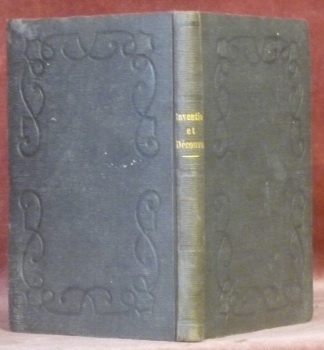
|
|
|
BECQUEREL, Henri.
Recherches sur une propriété nouvelle de la matière. Activité radiante spontanée ou radioactivité de la matière. Mémoires de l’Académie des Sciences de l’Institut de France. Tome quarante-sixième.
Paris, Typographie de Firmin-Didot et Cie. 1903, 300x245mm, 360pages, broché. Couverture supérieure détachée, dos fendu. A faire relier. Intérieure en très bon état, aucun défaut. Sous emboitage. Cet exemplaire attend les soins d’un bon reliure afin d’en être dignement et justement habillé selon son importance historique et son impacte phénomal dans les découvertes scientifiques.
Bookseller reference : 80428

|
|
|
LA COSA, Jean de. - OLAGUË, Ignacio.
Journal de bord de Jean de La Cosa, second de Christophe Colomb. Présenté et commenté.
Paris, Les Editions de Paris 1957, 185x140mm, 250pages, reliure toile sous jaquette en rhodoïde. Dos insolé, autrement bel exemplaire.
Bookseller reference : 91200

|
|
|
FLAHAULT, Ch.
Nordenskiold. Notice sur sa vie et ses voyages. (Avec un portrait et une carte lithographiée).
Paris, K. Nilson 1880, 240x155mm, frontispice, 76pages, broché. Déchirures sur les bords des couverture et au dos. Signature de l’auteur sur le haut de la couverture supérieure, intérieur propre.
Bookseller reference : 104389
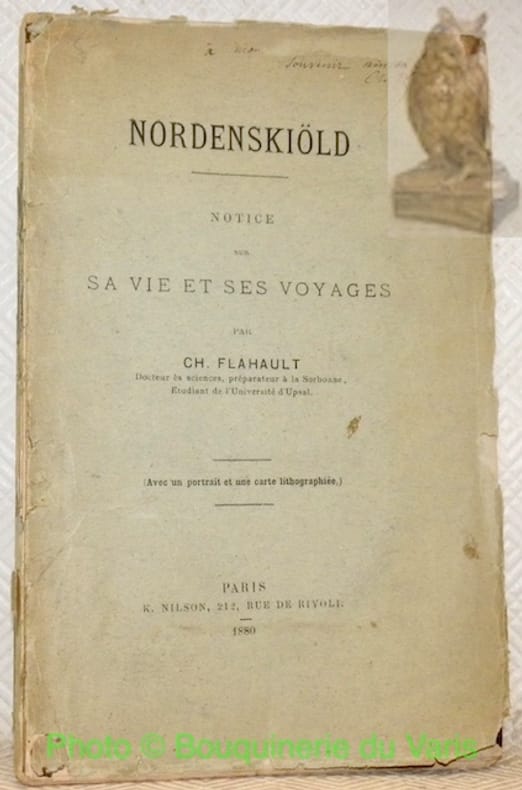
|
|